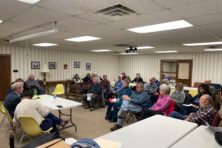When the WPA Brought an Art Master to Sturgeon Bay
- Share
- Tweet
- Pin
- Share

Sturgeon Bay post office patrons might not realize that they walk past the work of one of Wisconsin’s masters of Social Realism when they buy stamps or mail packages.
The 5-foot by 15-foot mural installed in 1940 above the entrance to the postmaster’s office maintains great historical value even if it does not convey the deep, impactful messages of some of Santos Zingale’s works from the 1930s, such as a disturbing Jim Crow-era exposé piece titled “Lynch Law.”
Getting paid and putting food on the table during the Great Depression motivated the Milwaukee-born artist to create his painting in egg tempera, “Fruits of Sturgeon Bay.”
President Franklin Delano Roosevelt’s New Deal programs and Works Progress Administration (WPA) provided work for laborers, writers and artists and art teachers, like Zingale and Sturgeon Bay native Jessie Kalmbach Chase, who created two murals that were rescued before demolition of the old Sturgeon Bay High School.
The Treasury Section of Fine Arts commissioned more than 3,000 murals to be painted on walls or installed inside post offices, including those at Sturgeon Bay and Kewaunee.
To research his work and acclimate Door County, Zingale was welcomed for a week in 1939 at Jens Jensen’s Ellison Bay property, The Clearing, and also gained input with area residents who were invited via posters and local newspapers to share ideas with him at the post office, according to a February 1939 Door County Advocate article.
He chose to paint a commercial lake trout fishing scene with orchards in bloom in the background, but WPA-era post office muralists’ preliminary sketches still needed approval from the postmaster and federal officials.
Zingale’s brand of realism did not strive for camera-like perfection. He worked to create works that were representative and told a story, said Helen del Guidice, Curator of Exhibitions and Collections at the Miller Art Museum in Sturgeon Bay.

Del Guidice said Zingale became involved in the 1930s in Social Realism, which doesn’t mean perfectionist painting but rather depicting scenes of social importance or pictures that accurately portrayed daily life.
Social Realism was looking at the plight of the individuals “in this grave time at the beginning of the 20th century” – showing poverty, back alleys, crowded buses, codified racism and people doing backbreaking work – during the Great Depression and World Wars I and II, she said.
“They were using art almost journalistically to document the plight of Americans,” del Guidice said.
The Social Realists didn’t always depict hard work and social issues. The mural in the Kewaunee post office shows people tobogganing and skiing. That art, similar to Zingale’s and his fellow Ashcan School devotees, shows figures with rounded shoulders and undefined musculature, and facial features that show emotion but not portrait-perfect depictions.
One of Zingale’s more unusual sketches, “Cigar Sniper,” a 1937 lithograph in a collection in Madison, shows a man near a trash can picking up a cigar butt from the gutter to smoke what’s left of it.
“That would have been considered vulgar at that time,” del Guidice said.
Del Guidice said it’s something people could see happening every day, but no Impressionist from the turn of the century would have painted and documented that scene. Earlier artists made pictures of “things that were suitable and beautiful,” Del Guidice said, noting Social Realists, as well as some of their surrealist brethren, were considered radical.
Del Guidice has one Zingale black-and-white print in the Miller Art Museum collection, but has not displayed it since it appeared, without publicity, in a 2019 exhibition from the museum’s surrealism collection.

Santos Zingale, whose self-portrait appears in Miller Art Museum files, visited Jens Jensen at The Clearing while gaining inspiration for his Sturgeon Bay post office mural. Photo by Craig Sterrett. 
Wisconsin Veterans Museum in Madison has more than 40 works that Santos Zingale created in his free time, documenting life – as well as some boredom near the catapult – aboard the heavy cruiser USS Bremerton. Image courtesy of Wisconsin Veterans Museum.
Looking at the print of a pueblo abandoned centuries ago, somewhere in the American Southwest, del Guidice said Zingale chose to show no outer walls, depicting the dwellings’ compartments as uninhabitable.
“There’s a certain down-to-earthness and kind of a nervous line, a little frantic,” she said of his sketching. “There’s a certain unclarity in the way he draws.”
Zingale paintings inhabit collections at museums in Milwaukee; the University of Wisconsin-Madison, where he taught until 1978; the Smithsonian, which accepted a smaller, simpler Sturgeon Bay commercial-fishing painting from the Internal Revenue Service offices; Marquette University; and the Wisconsin Veterans Museum.
The veterans museum has more than 40 of Zingale’s art created during his free time, mostly sketches of his tired, resting or bored shipmates on the heavy cruiser USS Bremerton from 1944-46.
“The museum purchased most of these sketches in 1996 from Zingale; his widow also donated some,” said Gregory Krueger, veterans museum curator of exhibits, who noted the sketches are available as a traveling exhibit.


